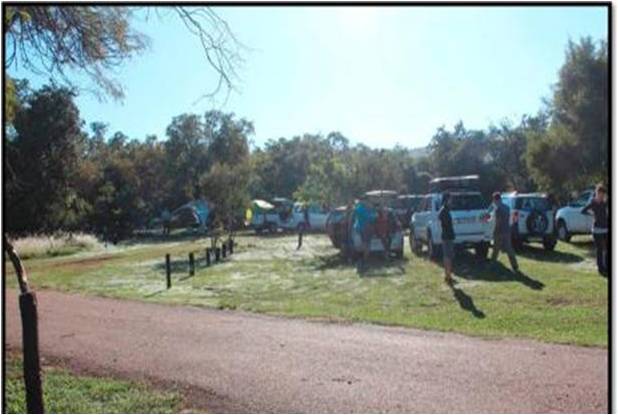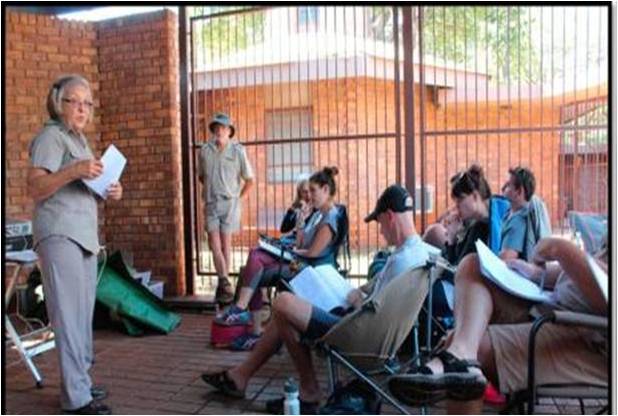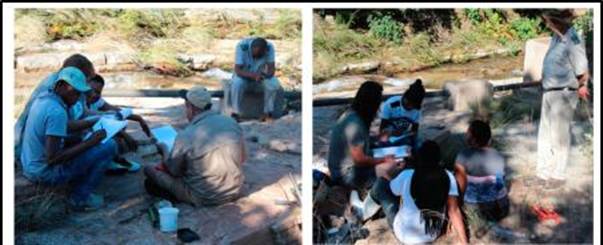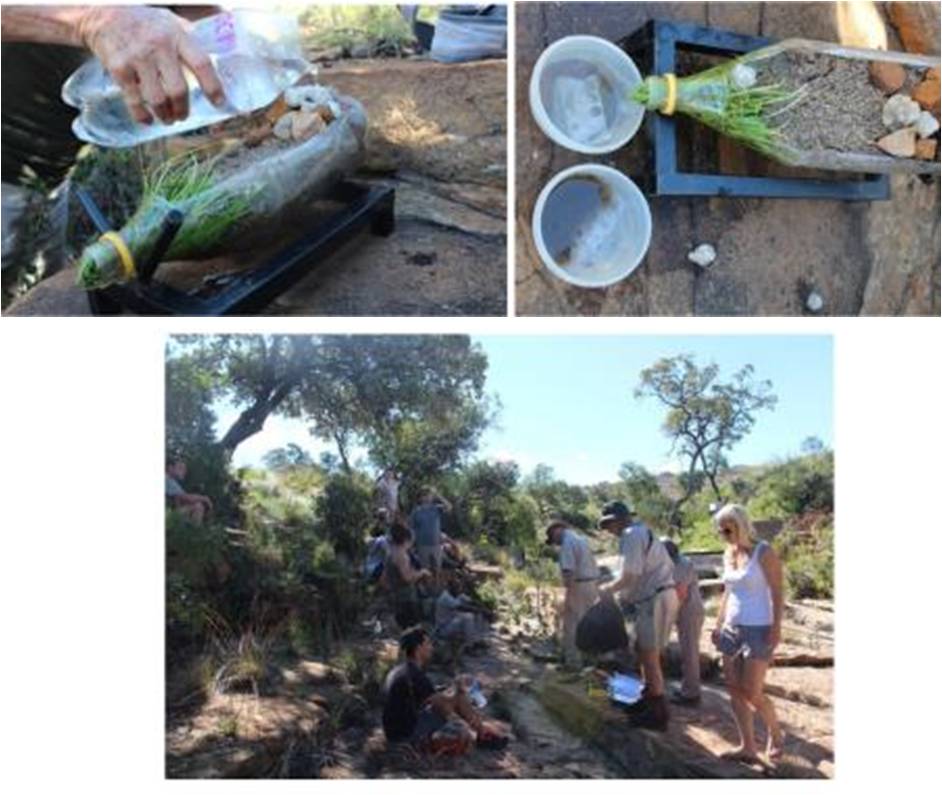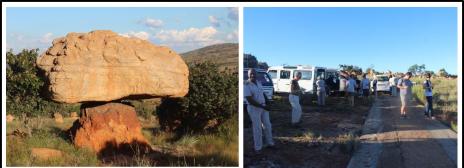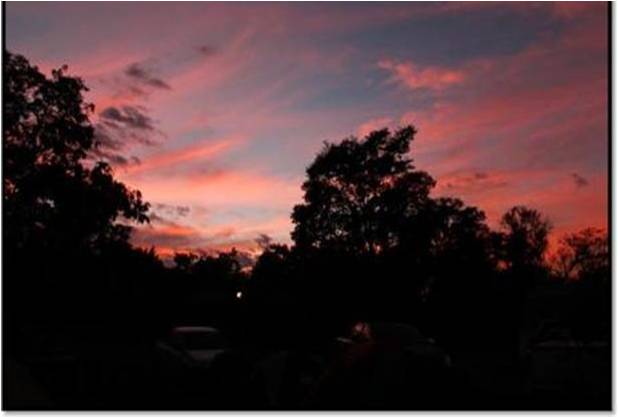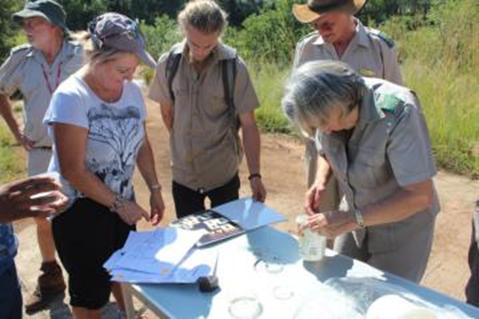The Wetlands weekend started out slightly differently from our other weekends, as there was no exam on Friday night, it was arranged that we would only start early Saturday morning. We spent the weekend in Kgaswane, a nature reserve just outside Rustenburg. Kgaswane is a great example of a catchment, and the view from the mountains is excellent!
Saturday 17.04.2018
Being at the park gate at 06:00 in the morning sure was a big thing! The seasons have started to change and at 06:00 it was only beginning to get light and the temperature was cooler than any of our previous “Summary” Saturday mornings. We then went straight to the campsite as a gathering point and it was- Ready… Set… GO!
Fig. 1: Saturday morning at the campsite
As a starter we were told that this weekend there would be an open book test on Sunday afternoon and that we should not underestimate the difficulty of the test. Maria was the lecturer for the weekend, and she perfectly conveyed the message about the necessity of water and, more importantly, the scarcity thereof. We discussed the destruction of wetlands in South Africa and the often poor decisions made by the people in charge. During the lecture we were given a sheet showing various human activities such as mining, farming, plantations, cities, etc. and asked to answer a number of questions. From this it was clear that the influence we have, in our everyday lives, on the quality of water is tremendous!
We took quick breaks in-between lectures, but the morning was mostly spent on theory. Although theory can be daunting, as we spent the morning in an “open” classroom (well, practically outside), we were able to hear the morning unfold – a blessing bestowed on very few! Round about 12:00 we were though the material and it was time to eat lunch and get the tents up.
Fig. 2: Theory in the ‘open’ classroom Saturday
Practical followed the lunch break, and we were all very excited to get going. Some of us went by vehicle to the site, and some of us took the hiking trail.
We went to the Waterkloofspruit in Kgaswane to do the experiment. In this exercise we were split into four groups to build our own wetland. We had to use grass to plug the hole of a 2lt. bottle and then we had to fill it up with coarse gravel and fine gravel collected in the river. First, we recorded the time it took the water to drain through the system. Then we had to make some murky water by adding dirt to the water and pour that through the system to see the colour of the water afterwards. This really put the function of cleaning the water into perspective. The water that was poured through the system was almost clear, and all the dirt was filtered out! Wetlands ARE natural filters! The practical changed our whole perspective of wetlands. In the theory session, Maria had explained how the wetlands are a natural filtrating system that cleans the water. Sounds obvious – but it is far greater than theory can explain!
We also had a sheet of questions to complete in our groups, and after the experiment was done, we gave feedback on our findings.
Fig. 3: Groups busy with the practical experiment at the river Saturday afternoon
Fig. 4: The experiment in action.
Above left: the time that it takes water to circulate through the system
Above right: how Wetlands are the natural filters of our world.
Above Bottom: the teams in action.
Tired but utterly satisfied, we went for sundowners at mushroom rock! There we discussed the day’s activities, the course so-far, and life in general. We explored the vegetation around the mountain, and the rocks that went through weathering and formed the most astonishing formation. To close the day’s events, we had the most amazing sunset with such an interesting cloud formation caused by the wind and the surrounding mountains.
Fig. 5: Sundowners at mushroom rock
Fig. 6: Sunset Saturday
Back at camp we started a fire and prepared our meals. Although the fire was much appreciated, going to bed was far better after such an eventful day and early morning.
Sunday 18.04.2018
Fig. 7: Sunrise Sunday morning
Sunday morning started at 08:00 back at the practical site. We were divided into our four different groups, and we were given different assignments to do. This included measuring the water temperatures and oxygen levels, speed and the flow of the water, the turbidity, pH, Nitrite ions, Chlorine and Hardness of the water. After doing the experiments; we gave feedback and then went to another site lower down the river to do the same measurements and compare the results.
Fig. 8: Practical experiments taking place Sunday morning
At the second site, we also undertook a mini-SASS exercise to determine the health of the river. This was done by capturing macroinvertebrates with a net and then taking our samples back to the table, to look at them through a loupe in order to identify the different families found using a dichotomous key. Macroinvertebrates are used because they are generally easy to collect and identify, and because different macroinvertebrates have different sensitivities to water quality conditions. This means that whether the water is “healthy” or not is determined by looking at the presence or absence of various macroinvertebrates.
A few of the macroinvertebrates we found in the river were cased caddisflies, uncased caddisflies, dragonfly larvae, crabs, pond skaters and whirligig beetles.
Fig. 9: Maria investigating the macroinvertebrates with one of the teams.
After a fun morning in the sun we were ready to head back. We cleaned the equipment and put all the macroinvertebrates back in the water. But before we went home, we had a delightful meeting with a young puff adder sunning itself in the road.
Back at the camp we had 10 minutes to quickly drink some water and have a snack if necessary, and then we headed off for the test.
We walked out of the test more confident than usual (since it was an open book), but hopefully not over confident. Then it was back to the camp to pack up and say our goodbyes, and head home with a new perspective of wetlands.
ED’s Note: Thanks Tanya, another very comprehensive report on a very important topic.
